似懂非懂,一定要搞懂基础的,剩下的边做边学,从案例中入手。
有关cmake的介绍,请参考:
1、https://www.cnblogs.com/pam-sh/p/13885959.html
2、https://www.cnblogs.com/pam-sh/p/14800154.html
1、文件结构

2、CMakeLists文件
#该项目所支持cmake的最低版本号
cmake_minimum_required(VERSION 3.5)
#项目名称
project (hello_cmake)
#指定从源文件生成可执行文件
add_executable(hello_cmake main.cpp)
注释:
(1)一般将项目名称作为可执行文件名
add_executable(${PROJECT_NAME} main.cpp)
1、文件结构
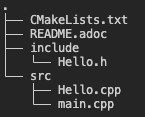
2、CMakeLists文件
cmake_minimum_required(VERSION 3.5)
project (hello_headers)
# 创建一个源文件变量,表示多个源文件(cpp)
set(SOURCES
src/Hello.cpp
src/main.cpp
)
add_executable(hello_headers ${SOURCES})
# 存在不同文件夹(头文件)时,使用该命令让编译器知道,其中PRIVATE表示include文件的使用范围target_include_directories(hello_headers
PRIVATE
${PROJECT_SOURCE_DIR}/include
)
注释:
1、变量说明
CMake语法指定了许多变量,可用于帮助在项目或源代码树中查找有用的目录。其中包括:
(1)CMAKE_SOURCE_DIR:项目根目录
(2)CMAKE_CURRENT_SOURCE_DIR:当前项目原目录(若存在子项目)
(3)PROJECT_SOURCE_DIR:当前cmake项目的源目录。
(4)CMAKE_BINARY_DIR:binary / build的目录,即运行cmake的目录
(5)CMAKE_CURRENT_BINARY_DIR:当前所在的build目录
(6)PROJECT_BINARY_DIR:当前项目的build目录
2、在创建源文件变量时可以使用通配符
#利用GLOB命令,识别通配符,
file(GLOB SOURCES "src/*.cpp")
3、target_include_directories() 中的权限
(1)PRIVATE:被添加到目标include目录
(2)INTERFACE:被添加到任何链接此库的目录中
(3)PUBLIC:此库和其他目标都有链接
这里include中的头文件,正好对应着文件中过的引用。
C-static-library(静态库)1、文件结构
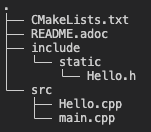
2、CMakeLists文件
cmake_minimum_required(VERSION 3.5)
project(hello_library)
############################################################
# Create a library
############################################################
#从源文件中生成一个静态库(libhello_library.a)
add_library(hello_library STATIC
src/Hello.cpp
)
target_include_directories(hello_library
PUBLIC
${PROJECT_SOURCE_DIR}/include
)
############################################################
# Create an executable
############################################################
# Add an executable with the above sources
add_executable(hello_binary
src/main.cpp
)
# 链接静态库,即将该静态库告知编译器
target_link_libraries( hello_binary
PRIVATE
hello_library
)
注释:
1、使用add_library()将源文件转换为静态库
2、使用target_link_libraries()函数导入静态库
1、文件结构
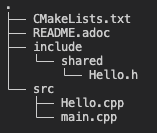
2、CMakeLists文件
cmake_minimum_required(VERSION 3.5)
project(hello_library)
############################################################
# Create a library
############################################################
#从源文件中生成一个分析库/动态库(libhello_library.so/libhello_library.dylib)
add_library(hello_library SHARED
src/Hello.cpp
)
# 给动态库取一个别名,可以代替该库使用
add_library(hello::library ALIAS hello_library)
target_include_directories(hello_library
PUBLIC
${PROJECT_SOURCE_DIR}/include
)
############################################################
# Create an executable
############################################################
# Add an executable with the above sources
add_executable(hello_binary
src/main.cpp
)
# 链接此动态库
target_link_libraries( hello_binary
PRIVATE
hello::library
)
1、文件结构
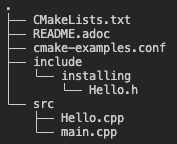
2、CMakeLists文件
cmake_minimum_required(VERSION 3.5)
project(cmake_examples_install)
############################################################
# Create a library
############################################################
#创建一个动态库
add_library(cmake_examples_inst SHARED
src/Hello.cpp
)
# 引入头文件
target_include_directories(cmake_examples_inst
PUBLIC
${PROJECT_SOURCE_DIR}/include
)
############################################################
# Create an executable
############################################################
# Add an executable with the above sources
add_executable(cmake_examples_inst_bin
src/main.cpp
)
#链接动态库
# link the new hello_library target with the hello_binary target
target_link_libraries( cmake_examples_inst_bin
PRIVATE
cmake_examples_inst
)
############################################################
# Install
#${CMAKE_INSTALL_PREFIX}默认是/usr/local
############################################################
# 将生成的可执行文件(cmake_examples_inst_bin)下载到${CMAKE_INSTALL_PREFIX}/bin文件夹下,
install (TARGETS cmake_examples_inst_bin
DESTINATION bin)
# 将生成的动态库(libcmake_examples_inst.dylib)下载到${CMAKE_INSTALL_PREFIX}/lib文件夹下
# Note: may not work on windows
install (TARGETS cmake_examples_inst
LIBRARY DESTINATION lib)
# 将该库的头文件下载到${CMAKE_INSTALL_PREFIX}/include文件夹下
install(DIRECTORY ${PROJECT_SOURCE_DIR}/include/
DESTINATION include)
# 将该库的设置文件下载到${CMAKE_INSTALL_PREFIX}/etc文件夹下
install (FILES cmake-examples.conf
DESTINATION etc)
注释:
1、在make install时,若在Windows平台中:
install (TARGETS cmake_examples_inst
LIBRARY DESTINATION lib
RUNTIME DESTINATION bin)
2、在make install 后,会生成install_manifest.txt文件,记录下载的信息
3、下载位置默认为:/usr/local,可以通过该方式指定下载位置:
(1)在cmake时每次手动指定
cmake .. -DCMAKE_INSTALL_PREFIX=/install/location
(2)在CMakeLists文件中指定
if( CMAKE_INSTALL_PREFIX_INITIALIZED_TO_DEFAULT )
message(STATUS "Setting default CMAKE_INSTALL_PREFIX path to ${CMAKE_BINARY_DIR}/install")
set(CMAKE_INSTALL_PREFIX "${CMAKE_BINARY_DIR}/install" CACHE STRING "The path to use for make install" FORCE)
endif()
(3)在make时手动指定
make install DESTDIR=指定安装位置
1、文件结构

2、CMakeLists文件
# Set the minimum version of CMake that can be used
# To find the cmake version run
# $ cmake --version
cmake_minimum_required(VERSION 3.5)
# 设置默认调试类型(RelWithDebInfo)
if(NOT CMAKE_BUILD_TYPE AND NOT CMAKE_CONFIGURATION_TYPES)
message("Setting build type to 'RelWithDebInfo' as none was specified.")
set(CMAKE_BUILD_TYPE RelWithDebInfo CACHE STRING "Choose the type of build." FORCE)
# Set the possible values of build type for cmake-gui
set_property(CACHE CMAKE_BUILD_TYPE PROPERTY STRINGS "Debug" "Release"
"MinSizeRel" "RelWithDebInfo")
endif()
# Set the project name
project (build_type)
# Add an executable
add_executable(cmake_examples_build_type main.cpp)
注释:
1、在调试build时,可以指定调试类型:
(1)Release:命令参数 -O3 -DNDEBUG
(2)Debug:命令参数 -g
(3)MinSizeRel:命令参数 -Os -DNDEBUG
(4)RelWithDebInfo:命令参数 -O2 -g -DNDEBUG
可以手动设置:
cmake .. -DCMAKE_BUILD_TYPE=Release/Debug/MinSizeRel/RelWithDebInfo
也可以设置为默认:
if(NOT CMAKE_BUILD_TYPE AND NOT CMAKE_CONFIGURATION_TYPES)
message("Setting build type to 'RelWithDebInfo' as none was specified.")
set(CMAKE_BUILD_TYPE RelWithDebInfo CACHE STRING "Choose the type of build." FORCE)
# Set the possible values of build type for cmake-gui
set_property(CACHE CMAKE_BUILD_TYPE PROPERTY STRINGS "Debug" "Release"
"MinSizeRel" "RelWithDebInfo")
endif()
也可以在cmake中设置:
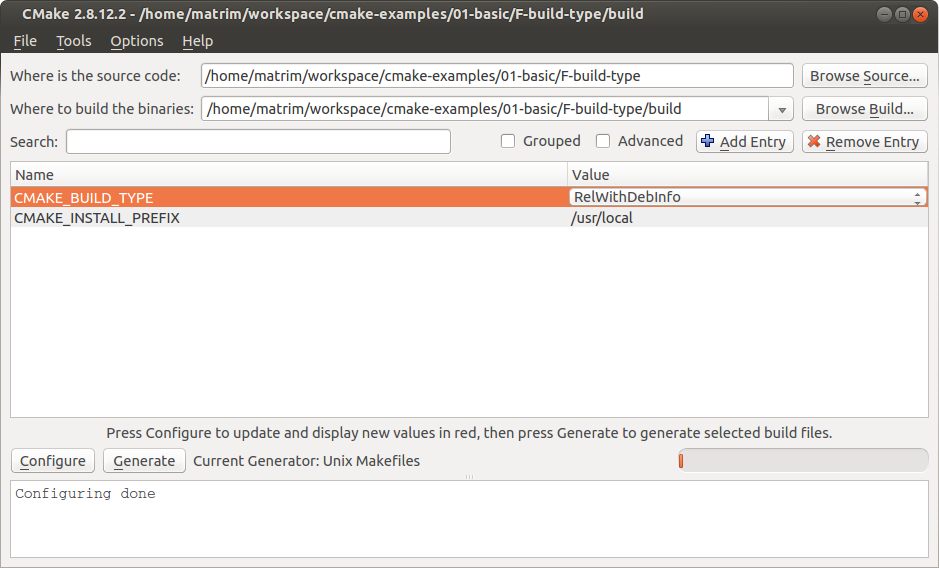
1、文件结构

2、CMakeLists文件
注释:
1、使用target_compile_definitions()函数
2、使用CMAKE_C_FLAGS 和 CMAKE_CXX_FLAGS变量
H-third-party-library(第三方库)在cmake中,使用find_package()函数引入第三方库,它能找到CMAKE_MODULE_PATH(默认为/usr/share/cmake/Modules)目录下的FindXXX.cmake文件。
这里以Boost库为例,boost更多可参考:https://www.cnblogs.com/pam-sh/p/16107753.html
1、文件结构

2、CMakeLists文件
cmake_minimum_required(VERSION 3.5)
# Set the project name
project (third_party_include)
# 使用库文件系统和系统查找boost库的.cmake文件
find_package(Boost 1.46.1 REQUIRED COMPONENTS filesystem system)
# 检查是否找到boost
if(Boost_FOUND)
message ("boost found")
else()
message (FATAL_ERROR "Cannot find Boost")
endif()
# Add an executable
add_executable(third_party_include main.cpp)
# 链接boost库
target_link_libraries( third_party_include
PRIVATE
Boost::filesystem
)
注释:
1、find_package()
可以在CMAKE_MODULE_PATH目录下查找类似FindXXX.cmake的文件。
解释一下:find_package(Boost 1.46.1 REQUIRED COMPONENTS filesystem system)
- Boost:表示引入的第三方库的名字,找的就是FindBoost.cmake
- 1.46.1:表示支持的boost最低版本
- REQUIRED:表示这库是必要要有的,不然会出错
- COMPONENTS:表示会在哪找这个库,filesystem和system表示。。
2、Checking if the package is found
很多库中都会设置一个变量“XXX_FOUND”,能够检查系统中是否存在对应的库,以boost为例:
if(Boost_FOUND)
message ("boost found")
include_directories(${Boost_INCLUDE_DIRS})
else()
message (FATAL_ERROR "Cannot find Boost")
endif()
在找到包后,通常会导出一些变量,告知库的头文件、静态文件、可执行文件在哪个位置,这些信息通畅里记录在FindXXX.cmake文件中。
上面例子中的:Boost_INCLUDE_DIRS就表示boost库的头文件。
可以使用ccmake和cmake-gui在缓存中检查这些变量。
3、别名
当前很多库会使用别名,更加方便的表示,比如boost库,会使用Boost::导出别名:
- Boost::boost:仅表示库的头文件
- Boost::system:表示boost系统库
- Boost::filesystem :表示文件系统
并且会有依赖关系,当使用Boost::filesystem时,会依赖于Boost::boost 和 Boost::system
如果要有针对的导入,可以使用:
target_link_libraries( third_party_include
PRIVATE
Boost::filesystem
)
而不使用别名时,则会单独指出:
# Include the boost headers
target_include_directories( third_party_include
PRIVATE ${Boost_INCLUDE_DIRS}
)
# link against the boost libraries
target_link_libraries( third_party_include
PRIVATE
${Boost_SYSTEM_LIBRARY}
${Boost_FILESYSTEM_LIBRARY}
)
其中:
target_include_directories:指向库的include目录,即表示库的头文件
target_link_libraries:表示库的路径
1、https://github.com/ttroy50/cmake-examples
这是一个学习cmake的地方,有很多案例可以学习,从浅入深
2、https://pan.baidu.com/s/1Bvzy0gK4O5vEYti3VV2A5g
提取码:0un9,别人总结的笔记
3、CmakeList入门
